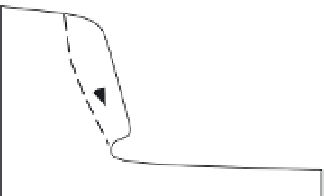Geology Reference
In-Depth Information
fall into two classes: constructional terraces
associated with coral reefs, and destructional or
erosional terraces. Terraces ultimately result
from the wide variation in sea level with time,
this variation being driven by a combination of
the histories of the local movement of the
landmass with respect to the geoid and the
global variations in sea level. The global or
eustatic
sea-level changes within the Pleistocene
are caused primarily by changes in the volumes
of the continental ice sheets. The associated
swings in sea level are huge: 120-150 m. Only
20 kyr ago, sea level was ~120 m below its
present level (Fairbanks, 1989; Lambeck and
Chappell, 2001). As both physical and biological
processes are strongly focused at the intersection
of land and sea, it is not surprising that the
variations in the location of this interface
through time have left a pronounced and,
therefore, useful geomorphic record.
The constant attack on the shoreline by waves
creates erosional marine terraces. As waves
crash against a coast, fluid turbulence and
hydraulic pressure are capable of loosening and
plucking fragments of bedrock, whereas sediment
entrained in the water can impact forcefully
against the cliffs. In places, this persistent attack
can form a
wave-cut notch
at the base of a sea
cliff. As plucking and abrasion continue, the
notch deepens, the base of the cliff retreats,
and the shore platform widens. In response
to undercutting, the slope of the sea cliff is
effectively steepened and can be expected to
collapse when stable slope angles are exceeded.
If the material that is loosened at the cliff face is
not removed, it simply mantles the bedrock and
prevents subsequent erosion. More commonly,
however, a seaward-sloping shoreline platform
or
abrasion ramp
permits wave energy to
transport the eroded debris into deeper water
offshore. This ramp typically slopes at about
1
°
and extends sufficiently seaward to allow
sediment that is transported along its surface
to be dumped into deeper water, dissolved, or
transported away in suspension following further
comminution. Because wave energy is needed
to transport sediment on the abrasion ramp,
these ramps do not extend below the typical
wave base (~10 m in most coastal areas). Given
potential mass
movement
Wave-cut
Platform
sea cliff
abrasion
shoreline
angle
eustatic sea level
ramp
wave-cut
notch
~1
°
slope
time
Fig. 2.1
Abrasion platform, sea cliff, wave-cut notch,
and shoreline angle.
The vertical position of the abrasion ramp varies
through time as a function of sea-level variations.
°
the 1
slope of the ramp, this sets a maximum
width of about 500 m for most abrasion ramps.
Wider ramps can result from a deeper wave base,
gentler seaward slopes, or multiple occupations
of approximately the same or slightly higher
relative sea-level positions.
A newly created erosional marine terrace
typically consists of two distinct surfaces: an
abrasion ramp dipping seaward at ~1
°
; and a
sea cliff dipping seaward at the stable angle of
repose, given the strength and cohesion of the
bedrock that it comprises (Fig. 2.1 and Plate
1A). The junction of these bedrock surfaces is
called the
shoreline angle
(also called the
inner edge
of the platform), and it is here that
a wave-cut notch may be preserved. Because
this wave-cut notch and/or the junction
between the abrasion ramp and the sea cliff
occurs at the shoreline, it represents a marker
that closely approximates local sea level at the
time of its formation. Formally, this feature
records the intersection of sea level (which,
when averaged over many tidal cycles, closely
approximates the geoid) and the landmass.
Hence, it becomes a paleo-horizontal indicator
that permits assessment of both tilting parallel
to the coast and spatial variations in vertical
motions of the crust. When reconstructing the
former inner edge of an uplifted abrasion plat-
form, it is important to try to pinpoint the
position of the shoreline angle. Commonly,
however, the shoreline angle will have been
obscured by downslope motion of eroded
material from topographically higher slopes.
In these circumstances, sometimes the surface
of the abrasion platform well away from
























































